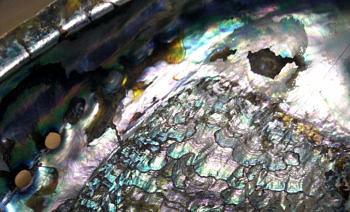Cracking the mystery of nature’s toughest material
Nacre—the rainbow-sheened material that lines the inside of mollusk shells and is better known as mother-of-pearl—has mystified scientists for more than 80 years. Long hailed among the toughest material on earth, its combination of hardness and resilience is stronger than anything yet created by humans using similar chemistry. Now, a team of materials scientists, earth scientists and biologists at the University of Michigan, University of Erlangen and elsewhere have revealed, for the first time, precisely how the mollusks are so incredibly tough.
Using electron microscopy and micro-indentation techniques, they’ve revealed a nanoscale architecture of organic and inorganic material that combines the best properties of layers and solids, hardness and resilience, into a nearly indestructible supermaterial.
What they’ve found could lead materials scientists to a new generation of ultra-strong synthetic materials for structures, surgical implants and countless other applications. A paper detailing the new discoveries was published on 24th October 2019 in Nature Communications.
“Mollusk shells have intrigued generations of scientists,” said Robert Hovden, an assistant professor of materials science and engineering at U-M and an author on the paper. “But we’ve never before been able to observe how they respond to stress in real time at the nanoscale. This paper, for the first time, shows in vivid detail exactly how the shells respond to impact.”
Researchers have known the basics about nacre for decades—it’s made of microscopic “bricks” of a mineral called aragonite, laced together with a “mortar” made of organic material. This brick-and-mortar arrangement clearly lends strength, but nacre is far more resilient than its materials suggest. Ab interdisciplinary team around the globe worked together to crack the mystery.
Using tiny piezo-electric micro-indenters, they were able to exert force on the shells while they were under an electron microscope and watch what happened in real time. They revealed the structure deforms with more complexity than imagined.
They found that the “bricks” are actually multi-sided tablets only a few hundred nanometers in size. Ordinarily, these tablets remain separate, arranged in layers and cushioned by a thin layer of organic “mortar.” But when stress is applied to the shells, the “mortar” squishes aside and the tablets lock together, forming what is essentially a solid surface. When the force is removed, the structure springs back, without losing any strength or resilience.
This resilience sets nacre apart from even the most advanced human-designed materials. Plastics, for example, can spring back from an impact, but they lose some of their strength each time. Nacre lost none of its resilience in repeated impacts at up to 80% of its yield strength.
What’s more, if a crack does form, nacre confines the crack to a single layer rather than allowing it to spread, keeping the shell’s structure intact—the mollusk lives another day. In essence, the material gains its strength by combining the advantages of solid and layered structures.
“It’s incredible that a mollusk, which is not the most intelligent creature, is fabricating such complex structures across so many scales,” Hovden said.
“The grain structure on the nanoscale is key to this hierarchical and hybrid organization. It arises from tiny particles which assemble on the nanoscale – in order to use our findings for future applications. We have to understand these exceptional processes en detail since they eventually lead to a ceramic material with fantastic properties.” Stephan Wolf added. He is a Juniorprofessor for Biomimetic Materials and Processes at Friedrich-Alexander-University Erlangen-Nürnberg, who also contributed to this study.
Hovden believes humans could use the mussel’s methods to create nano-engineered composite surfaces that could be dramatically lighter and tougher than those available today.
“Nature is handing us these highly optimized structures with millions of years of evolution behind them,” he said. “We could never run enough computer simulations to come up with these—they’re just there for us to discover.”
The paper is titled “Nanoscale deformation mechanics reveal resilience in nacre of Pinna nobilis shell.” Other universities involved with the project include Macquarie University, Sydney, Université de Bourgogne Franche-Comté and Friedrich-Alexander-University Erlangen-Nürnberg. The research was performed on electron microscopy instruments at the Michigan Center for Materials Characterization. The Mediterranean Pinna nobilis mollusk studied is a protected species due to recent ecological threats.
Gim, Jiseok, Noah Schnitzer, Laura M. Otter, Yuchi Cui, Sébastien Motreuil, Frédéric Marin, Stephan E. Wolf, Dorrit E. Jacob, Amit Misra, and Robert Hovden. 2019. “Nanoscale Deformation Mechanics Reveal Resilience in Nacre of Pinna Nobilis Shell.” Nature Communications 10 (1): 4822. https://doi.org/10.1038/s41467-019-12743-z.
